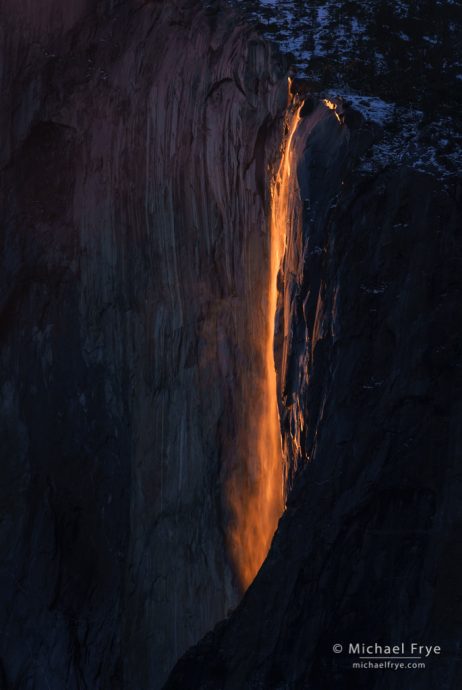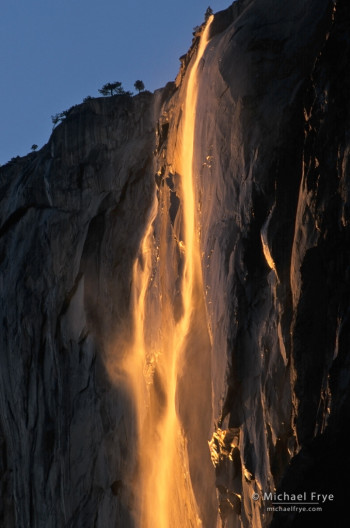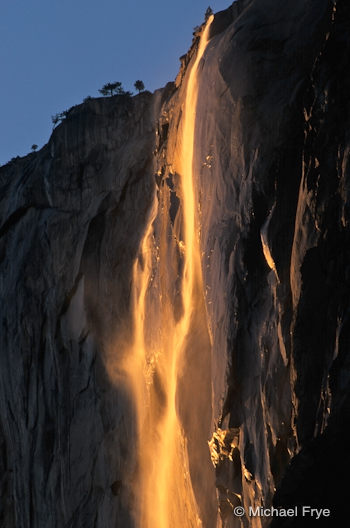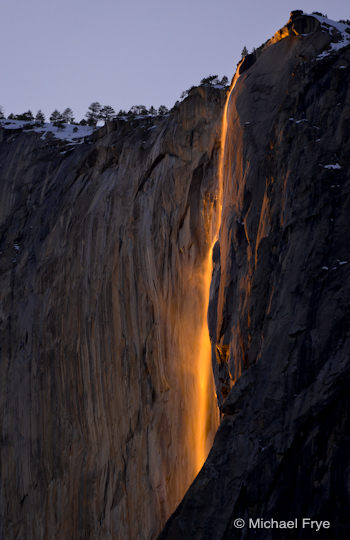by Michael Frye | Feb 10, 2017 | Yosemite Photo Conditions

Horsetail Fall at sunset, February 18th, 2016
It looks like there should be plenty of water in Horsetail Fall this month. Yosemite Valley has received almost ten inches of rain over the past week, and that abundant rainfall has boosted the flow in all of Yosemite’s waterfalls, including Horsetail. In fact the Merced River reached minor flood stage Wednesday night. While the rain runoff will diminish quickly, there’s a healthy snowpack at the higher elevations of Yosemite, which should keep Horsetail flowing for awhile. I expect above-average flow in Horsetail this year.
But water flow is just one element. You also need the sun to set at the right angle to backlight Horsetail and make it turn orange, yet have the cliff behind it in the shade, so that the glowing, backlit, orange water is set against a dark background. My best estimate is that this happens between February 16th and 23rd, and perhaps even a few days beyond. (I delve into more detail about all that here.)
(more…)
by Michael Frye | Jan 20, 2016 | Yosemite Photo Conditions

Horsetail Fall at sunset, Yosemite
We’re getting close to Horsetail Fall season, and I’m getting lots of questions about the water flow and the right time of year to photograph it.
As I said in my last post, there’s a healthy snowpack at higher elevations of Yosemite. Badger Pass ski area still reports 60 inches of snow on the ground at the base of the mountain (7,200 feet), and 72 inches at the top (8,000 feet). Horsetail’s small drainage on top of El Capitan lies at similar elevations, but faces south, and the slopes of Badger Pass face north. That means Horsetail’s drainage gets more sun, and the snow melts faster. But there should still be at least three or four feet of snow on top of El Cap right now, and it’s hard to imagine how all of that could melt between now and the third week of February. After four years of drought, it looks like we’ll finally have a good flow in Horsetail Fall at the right time of year.
But water flow is just one element. You also need the sun to set at the right angle to backlight Horsetail and make it turn orange, yet have the cliff behind it in the shade, so that the glowing, backlit, orange water is set against a dark background. My best estimate is that this happens between February 16th and 23rd, and perhaps even a few days beyond. (I delve into more detail about all that here.)
(more…)
by Michael Frye | Feb 21, 2012 | Yosemite Photo Conditions

Horsetail Fall at sunset, February 1995
What makes Horsetail Fall so special? It seemed appropriate at this time of year to re-post this article from my 25 Years in Yosemite blog, where I talk about the photographic history of this waterfall, and the unique topography that creates the lighting phenomenon so many photographers have tried to capture:
Many people remember Yosemite’s firefall. On summer evenings from 1872 until 1968 the owners and employees of the Glacier Point Hotel pushed burning hot embers off the top of the Glacier Point cliff toward Yosemite Valley. The effect resembled a waterfall of fire. When the hotel burned down in 1969 the park service decided to end the ritual because this unnatural event caused visitors to trample meadows in their attempts to find a viewing spot.
I first visited Yosemite in 1980, so I never saw the firefall. On the park’s centennial anniversary in 1990 rumors spread that the park service would reenact the firefall, unannounced, but it never happened.
Yosemite, though, has an amazing natural “firefall.” For about ten days each February, if conditions are right, a thin ribbon of water dropping from the East Buttress of El Capitan, called Horsetail Fall, turns vivid orange when backlit by the setting sun.
(more…)
by Michael Frye | Jan 26, 2012 | Yosemite Photo Conditions

Horsetail Fall from "Rowell's View" near Northside Drive, February 19th, 2009, 5:29 p.m.
That special time of year is approaching, when children write letters to Santa Claus, people put colorful lights on the their houses and inflatable reindeer on their lawns, and… oh wait, wrong one. That other special time of year is approaching, when photographers of every stripe migrate to a sheltered valley in the Sierra Nevada, and Nikon and Canon users stand side by side in peace and harmony, hoping for a break in the clouds and a moment of magic. Yes, Horsetail Fall season is coming.
The forecast for the season is, well, iffy. After two months with no precipitation whatsoever, Horsetail Fall was completely dry. But last weekend two storms dumped over five inches of rain in Yosemite Valley, and that precipitation fell as snow up higher. Horsetail Fall is fed by snow melting from a small drainage on top of El Capitan, and there is now some snow there, finally. But that’s not enough—we need two or three more snow dumps between now and mid-February. Then we need a stretch of clear, warm weather at the right time to melt some of that snow, feed the waterfall, and allow the sun to cast it’s golden, late-day light on the water. Not too much to ask, is it?
So when is that right time? An excellent question, but a difficult one to answer. In January 2009 I put an article on my web site describing how I used one of the Yosemite web cams to determine the optimum time for photographing Horsetail Fall. This was the best method I could find since it’s difficult to get on-the-ground first-hand information in February (too many clouds!). I thought the best time was an eleven-day window from approximately February 12th to 22nd.
My observations last year, however, have led me to question that conclusion. I photographed Horsetail on February 11th, and again on the 15th, and I think even the 15th was too early.
(more…)












